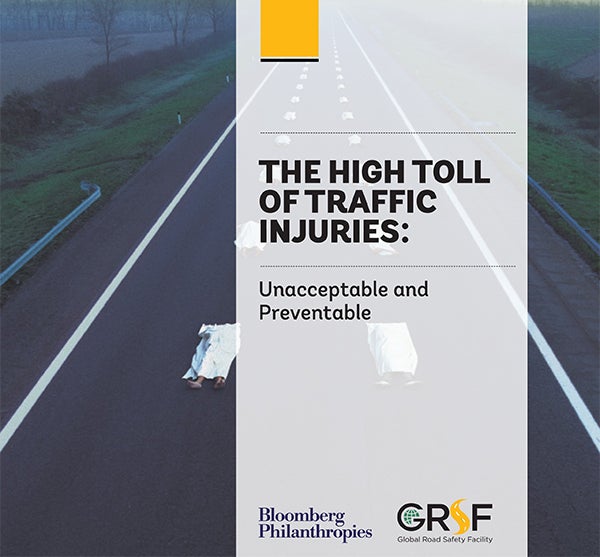
While reading a newspaper over the holidays, one of us came across an article with an often common story: “car collision causes mass fatalities on mountain road”. The collision resulted in 51 deaths, after a bus--one of the vehicles involved, plunged down a cliff in Peru. Many of the dead were returning to Lima after celebrating the New Year’s holiday with family outside the city.
The unfortunate reality is that these tragic events are a daily occurrence across the world. WHO data in 2015 show that 1.25 million people are killed on the world’s roads each year and another 20-50 million seriously injured. While the human toll is visible although underreported, the intangible costs that negatively impact societies and economies at large are not captured in national statistics. Data and lack of evidence on the economic and social cost of traffic crashes to inform policy making on road safety has proven to be difficult, especially in developing countries.
A new World Bank Group report, “The High Toll of Traffic Injuries: Unacceptable and Preventable”, prepared with the support of Bloomberg Philanthropies, attempts to fill this void. Building upon existing studies that estimate the economic burden of disease and premature death, and using data from 135 countries collected between 1990 and 2014, the report assesses both the potential economic growth benefits and aggregated social welfare gains from long-term reduction of traffic injuries and deaths in low- and middle-income countries (LMICs), focusing on an initial set of five countries: China, India, Philippines, Tanzania, and Thailand.
The results of the study and their implications for the development prospects of countries are hard to ignore. Besides preventing loss of life of people, and the resulting pain and misery bestowed on families and communities, there are significant long-term economic gains to be achieved from the adoption of simple, sustainable, affordable and effective traffic safety policies and interventions. The estimated impact ranges from a 7 to 22 percent increase in GDP per capita over 24 years – that can be achieved through substantial reduction in road traffic injuries and deaths in line with the target set under the UN’s Sustainable Development Goals 2030 Agenda. This finding is a clear message to governments: there is a significant economic loss associated with every year of inaction where LMICs fail to adopt effective policies and interventions to substantially reduce road traffic injuries and deaths.
The effect on national income growth, however, is only a part of the story. Since the intangible value society assigns to health is not captured in the income growth effect estimates, the study also assesses the enormous welfare benefits associated with what it would be worth to people to reduce the risk of road traffic injuries and deaths. Using value of statistical life (VSL) measures—the monetary value assigned for statistical purposes on a life saved through a policy measure—the study estimated additional welfare benefits equivalent to 6 to 32 percent of the national GDP that can be realized from reducing 50 percent of road traffic injuries and deaths over a period of 24 years.
As the report shows, much human potential is being lost unnecessarily due to traffic crashes. Beyond the enormous suffering they cause, as vividly captured in the devastating stories of people whose lives are ruined or never fully realized because of injuries, premature death, and long-lasting disabilities, the economic cost of road traffic injuries and death are unacceptably high. More importantly, country experiences from across the world have shown that if governments and other social actors are spurred into action and adopt effective and sustainable evidence-based policies and interventions, the loss of life and its effect on the society can be greatly reduced.
Looking ahead, the implications for action are clear. We should keep in mind that the prevention of road traffic injuries and premature deaths under transport sector interventions and as part of efforts to accelerate progress towards universal health coverage will pay off in terms of healthy life years, free of injuries and disabilities. This, in turn, will contribute to build health capital (the value of a person’s lifetime health) and hence, human capital (the sum of knowledge, skills, and know-how possessed by the population), which increasingly are the main source of a country’s total wealth and long-term success. Indeed, as recently highlighted by World Bank Group President, Dr. Jim Y. Kim, at a global forum on universal health coverage held in Tokyo, World Bank Group research clearly shows that the difference between the top quartile – the top 25 percent of countries that have improved human capital the most, compared with the bottom 25 percent – countries that have improved human capital the least – is enormous: between 1991 and 2016 – the difference in economic growth was 1.25 percent of GDP each year over 25 years.
As we enter a new year, let’s renew our commitment across sectors to help address one of the most significant global public health threats of the early 21st Century. In doing so, let’s be clear that we are not pursuing only a public health goal, but more importantly, a broad social goal that impacts all of us, since the reduction of preventable injuries and deaths due to traffic crashes is a key requirement for building healthy and resilient societies, dynamic and innovative economies, and the growth of living standards.



Join the Conversation